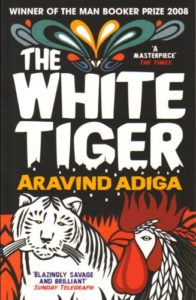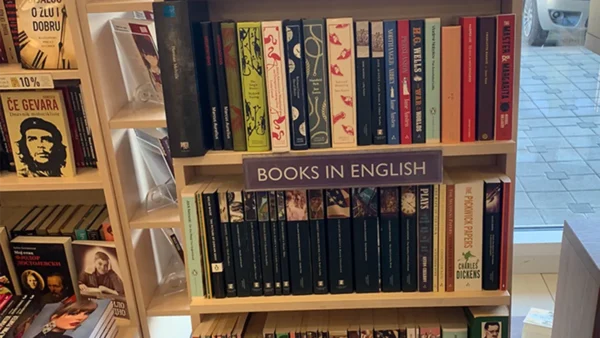 I didn’t like this book when I started it. Even when I was browsing it in the bookshop, I wasn’t that keen – I only bought it because it was half-price and it had won the Booker Prize. Surprising, then, that it ended up being one of the best books I’ve read in recent months.
I didn’t like this book when I started it. Even when I was browsing it in the bookshop, I wasn’t that keen – I only bought it because it was half-price and it had won the Booker Prize. Surprising, then, that it ended up being one of the best books I’ve read in recent months.
The style grated initially. It’s written as a series of letters from an Indian entrepreneur to Chinese Premier Wen Jiabao, and starts off full of stuff like “Let me tell you about my admiration for the great nation of China…” Fortunately this tails off after a while, and you can forget about Wen Jiabao and listen to the story of Balram’s rise from servant to successful businessman. And in the end, the narrative device does have a clever effect: it allows Balram to talk naturally about his life while also explaining aspects of Indian life that might not otherwise be clear to a foreigner. Wen Jiabao is a stand-in for us, the foreign reader who needs things explained to him. I don’t know if this was a conscious choice by Adiga to give his book both authenticity and international appeal; perhaps Wen Jiabao’s presence has a completely different purpose, and seeing him as a stand-in for me is just Western arrogance! But it works, anyway.
Despite the brief description I gave above, Balram’s story is not a traditional, uplifting rags to riches tale. It’s much darker than that, and much more real. In the traditional rags to riches tale, the protagonist faces lots of obstacles from his humble upbringing, but succeeds through strength of character in overcoming them and achieving the success he or she deserves. The problem with these tales is that they reinscribe some pervasive myths – that being successful is about strength of character, and that riches come to those who deserve them. Accepting these myths leaves you with a feeling that, conversely, those who stay poor must somehow also deserve it – they must somehow have lacked the strength of character to rise above their situation.
Adiga’s book challenges this narrative, replacing it with a darker and, to me, truer one. Balram becomes rich not through virtue or hard work – both of these qualities make him an ideal servant. He gets rich by lying, stealing and killing. This makes him like the other rich characters in the book, who live off extracting rents from the poor, killing those who rebel against them, paying bribes to government ministers, etc. Balram compares India to a rooster coop, in which the majority of people are trapped but don’t try to escape.
A handful of men in this country have trained the remaining 99.9 per cent – as strong, as talented, as intelligent in every way – to exist in perpetual servitude; a servitude so strong that you can put the key of his emancipation in a man’s hands and he will throw it back at you with a curse.
Clearly, this is a book about India, and some things are specific to India. The family, for example, is a strong unit in India, and Balram says it is the main way of keeping people trapped – they feel an obligation to their family, so will work hard and not rebel. When Balram does rebel, he assumes that the family of the rich man he murdered will kill all of his family in revenge – it’s the way it works. He does it anyway, because it’s the only way he can see to escape. He must sacrifice everything, from his honesty and morality and upbringing to his entire family. He must be utterly selfish.
I think it would be a mistake to see the book as being only about India, though. Of course the divide between rich and poor there is more extreme than in most other places on Earth. The servitude in which millions of poor people are trapped is almost unimaginable. But it’s still true everywhere, isn’t it, that a tiny percentage of people own the majority of the wealth? Are those people really so superior to the rest of us that they deserve that level of wealth? Do we really live in a meritocracy? Isn’t the accident of birth still incredibly important? Doesn’t every country have its own version of the rooster coop?
Nothing’s black and white, of course, and this is one of the virtues of the book. Although it makes strong points about inequality and justice, the characters still feel real. In a review like this things are necessarily summarised and simplified, but over the course of the novel the characters are fully fleshed out — the rich people are not just symbols of evil and the poor are not all virtuous. Adiga explores the complexities and contradictions while keeping his eye firmly set on his larger targets. I’m not always able to see what the Booker Prize judges see, but in this case I certainly can.



There are 4 comments
This was three years ago. I actually have the book stacked on my bookshelf, unread. It seems a little intimidating. I’ll have to reach for it one day, soon.
Time flies! I can’t believe it was back in 2009 that I wrote this. Anyway, thanks for the comment, Lucinda, and yes, I’d definitely recommend reading it. Made a real impression on me.
Hi – I’m new to your site so poking around. I read this book about a year or so ago..and really liked it. I forgot about it until reading your review. Will perhaps reread it soon.
Hi Mary
Thanks for poking around! This was a great book. I also forget about books pretty quickly – that’s why I keep this blog, as a record for myself and a reminder of books I enjoyed. Great to hear that it served the same purpose for someone else as well!